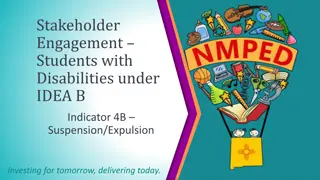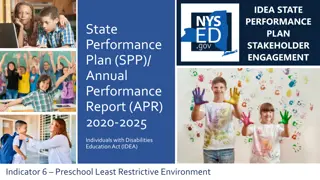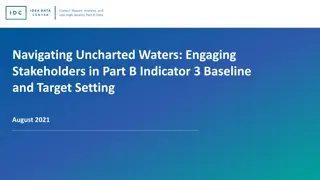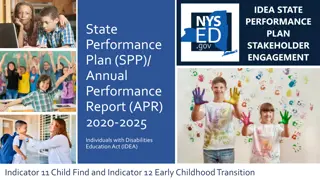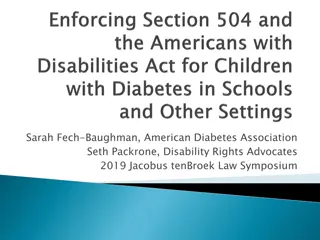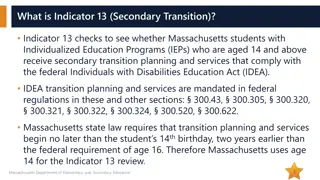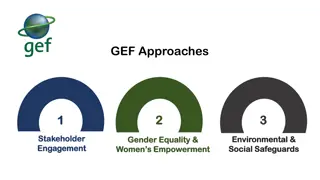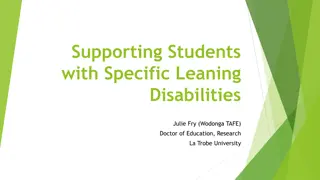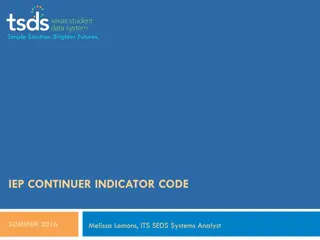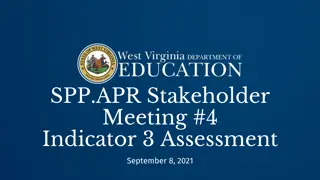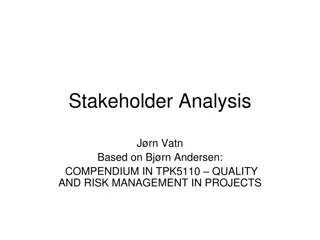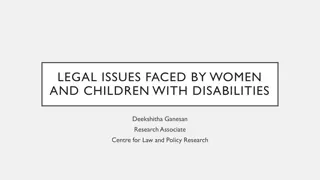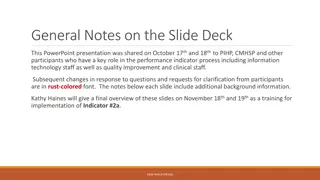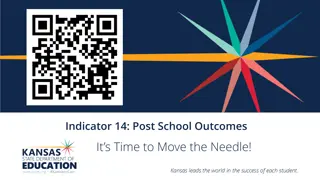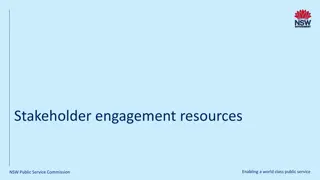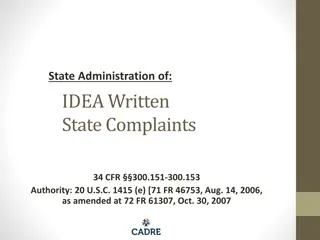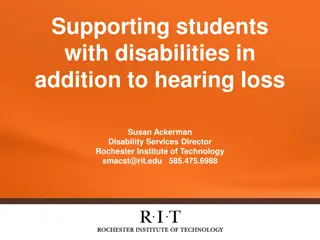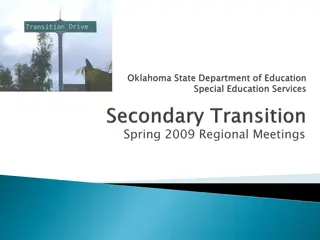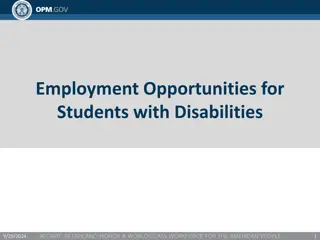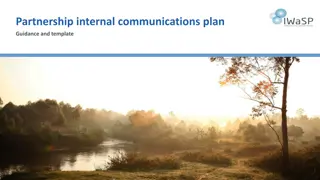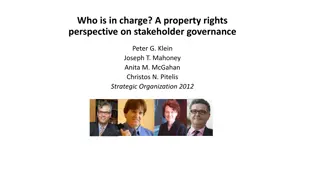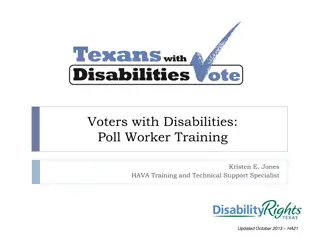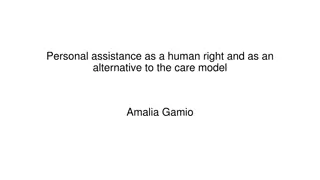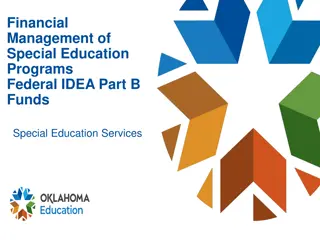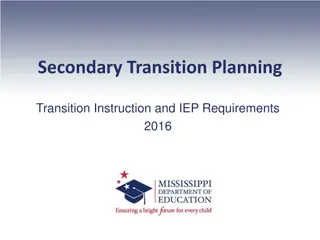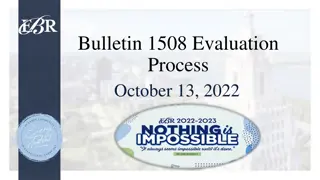Stakeholder Engagement for Students with Disabilities under IDEA B Indicator 4B
Engage stakeholders to review data and provide input on Indicator 4A, focusing on suspension and expulsion of students with disabilities. Meeting objectives include analyzing data, setting targets, and evaluating progress to enhance strategies for improvement. Meeting norms emphasize inclusivity and opportunities for parents/guardians to share their input via chat box and Jamboard. The meeting also covers an introduction to the State Performance Plan and Annual Performance Report required by IDEA Part B, outlining disability categories and services provided, excluding gifted students from reported data.
Download Presentation

Please find below an Image/Link to download the presentation.
The content on the website is provided AS IS for your information and personal use only. It may not be sold, licensed, or shared on other websites without obtaining consent from the author. Download presentation by click this link. If you encounter any issues during the download, it is possible that the publisher has removed the file from their server.
E N D
Presentation Transcript
Stakeholder Engagement Students with Disabilities under IDEA B Indicator 4B Suspension/Expulsion Investing for tomorrow, delivering today.
Todays Meeting Objectives Overview of the State Performance Plan (SPP)/Annual Performance (APR) required by the Individuals with Disabilities Education Act (IDEA)-Part B Review data available for Indicator: 4A Suspension and Expulsion Stakeholder input on each Indicator Data Analysis Target Setting Evaluating Progress Improvement Strategies 2 Investing for tomorrow, delivering today.
Housekeeping Meeting Norms Everyone has valuable information to provide Raise your hand via Zoom Liz Schweiger will acknowledge those with raised hands Lower hand 3 Investing for tomorrow, delivering today.
Housekeeping Meeting Norms Parents/Guardians will have the option to provide input first Chat box available for questions Moderated by Leah Johnson Jamboard available for feedback Moderated by Matthew Kump 4 Investing for tomorrow, delivering today.
Jamboard Matthew Kump
Introduction to the State Performance Plan (SPP)/Annual Performance Report (APR)
Individuals with Disabilities Education Act Part B A student that 1.Has a disability and 2.The need for specialized instruction Disability Categories: - Intellectual Disability - Hearing Impairment - Speech or Language Impairment - Visual Impairment - Emotional Disturbance - Orthopedic Impairment - Development Delayed (To age 8) - Autism - Traumatic Brain Injury - Other Heath Impairment - Specific Learning Disability - Deaf-Blindness - Multiple Disabilities Gifted Services are a New Mexico rule and gifted students are not counted in any of the data reported to the Office of Special Education Programs (OSEP) 7 Investing for tomorrow, delivering today.
Overview of the State Performance Plan (SPP)/ Annual Performance Report (APR) States receiving funds from the U.S. Department of Education, to implement the Individuals with Disabilities Education Act (IDEA) must develop a State Performance Plan (SPP) The SPP describes State efforts to meet the requirements and purposes of IDEA, Part B States must report on the performance of the SPP through the Annual Performance Report (APR) Completing the SPP and APR relies on the collection and use of a variety of data 8 Investing for tomorrow, delivering today.
IDEA B Indicators Reporting in the SPP/APR 2 Types of Indicators Compliance and Target Indicators Indicators up to FFY2019: Compliance Indicators Target Indicators Indicator 4B Suspension/Expulsion Indicator 8 Parent Involvement Indicator 1 Graduation Indicator 9 Disproportionate Representation Indicator 2 Drop out Indicator 14 Post-School Outcomes Indicator 10 Disproportionate Representation Indicator 15 Resolution Sessions Indicator 3B & 3C Assessment Participation & Outcomes Indicator 11 Child Find/60 Day Timeline Indicator 16 Mediation Indicator 4A Suspension/Expulsion Indicator 12 Part C to B Transition Indicator 5 Education Environments Indicator 13 Secondary Transition Indicator 6 Preschool Education Environments Indicator 7 Preschool Outcomes 9 Investing for tomorrow, delivering today.
IDEA B Indicators Changes in the SPP/APR Indicators for FFY2020 to FFY 2025: 10 Investing for tomorrow, delivering today.
Indicator 4A Suspension/Expulsion of Students with Disabilities
Indicator 4A Information Federal reporting measurement requirements FFY 2019 Rates of suspension and expulsion: Data Source: State discipline data, including State s analysis of State s Discipline data collected under IDEA Section 618, where applicable. Discrepancy can be computed by either comparing the rates of suspensions and expulsions for children with IEPs to rates for nondisabled children within the LEA or by comparing the rates of suspensions and expulsions for children with IEPs among LEAs within the State. 4. If the State has established a minimum n size requirement, the State may only include, in both the numerator and the denominator, districts that met that State-established n size. If the State used a minimum n size requirement, report the number of districts excluded from the calculation as a result of this requirement. A. Percent of districts that have a significant discrepancy in the rate of suspensions and expulsions of greater than 10 days in a school year for children with IEPs; and Describe the results of the State s examination of the data for the year before the reporting year (e.g., for the FFY 2018 SPP/APR, use data from 2017-2018), including data disaggregated by race and ethnicity to determine if significant discrepancies are occurring in the rates of long- term suspensions and expulsions of children with IEPs, as required at 20 U.S.C. 1412(a)(22). The State s examination must include one of the following comparisons: Measurement: B. Percent of districts that have: (a) a significant discrepancy, by race or ethnicity, in the rate of suspensions and expulsions of greater than 10 days in a school year for children with IEPs; and (b) policies, procedures or practices that contribute to the significant discrepancy and do not comply with requirements relating to the development and implementation of IEPs, the use of positive behavioral interventions and supports, and procedural safeguards. A.Percent = [(# of districts that meet the State- established n size (if applicable) that have a significant discrepancy in the rates of suspensions and expulsions for greater than 10 days in a school year of children with IEPs) divided by the (# of districts in the State that meet the State- established n size (if applicable))] times 100. B. Percent = [(# of districts that meet the State-established n size (if applicable) for one or more racial/ethnic groups that have: (a) a significant discrepancy, by race or ethnicity, in the rates of suspensions and expulsions of greater than 10 days in a school year of children with IEPs; and (b) policies, procedures or practices that contribute to the significant discrepancy and do not comply with requirements relating to the development and implementation of IEPs, the use of positive behavioral interventions and supports, and procedural safeguards) divided by the (# of districts in the State that meet the State-established n size (if applicable) for one or more racial/ethnic groups)] times 100. The rates of suspensions and expulsions for children with IEPs among LEAs within the State; or The rates of suspensions and expulsions for children with IEPs to nondisabled children within the LEAs. In the description, specify which method the State used to determine possible discrepancies and explain what constitutes those discrepancies. (20 U.S.C. 1416(a)(3)(A); 1412(a)(22)) Indicator 4A: Provide the actual numbers used in the calculation (based upon districts that met the minimum n size requirement, if applicable). If significant discrepancies occurred, describe how the State educational agency reviewed and, if appropriate, revised (or required the affected local educational agency to revise) its policies, procedures, and practices relating to the development and implementation of IEPs, the use of positive behavioral interventions and supports, and procedural safeguards, to ensure that such policies, procedures, and practices comply with applicable requirements. 12 Investing for tomorrow, delivering today. Include State s definition of significant discrepancy.
Indicator 4A Data FFY 2019 Data: Number of districts that have a significant discrepancy 1 Number of Districts that met the State's minimum n-size 141 FFY 2018 Data 0.00% FFY 2019 Target 0.80% FFY 2019 Data 0.71% Status Met Target Slippage No Slippage 13 Investing for tomorrow, delivering today.
Indicator 4A Information Reporting measurement requirements FFY 2020-2025 4. Rates of suspension and expulsion: Data Source: If the State has established a minimum n and/or cell size requirement, the State may only include, in both the numerator and the denominator, LEAs that met that State-established n and/or cell size. If the State used a minimum n and/or cell size requirement, report the number of LEAs totally excluded from the calculation as a result of this requirement. A. Percent of local educational agencies (LEA) that have a significant discrepancy, as defined by the State, in the rate of suspensions and expulsions of greater than 10 days in a school year for children with IEPs; and State discipline data, including State s analysis of State s Discipline data collected under IDEA Section 618, where applicable. Discrepancy can be computed by either comparing the rates of suspensions and expulsions for children with IEPs to rates for nondisabled children within the LEA or by comparing the rates of suspensions and expulsions for children with IEPs among LEAs within the State. Describe the results of the State s examination of the data for the year before the reporting year (e.g., for the FFY 2020 SPP/APR, use data from 2019-2020), including data disaggregated by race and ethnicity todetermine if significant discrepancies, as defined by the State, are occurring in the rates of long-term suspensions and expulsions (more than 10 days during the school year) of children with IEPs, as required at 20 U.S.C. 1412(a)(22). The State s examination must include one of the following comparisons: The rates of suspensions and expulsions for children with IEPs among LEAs within the State; or B. Percent of LEAs that have: (a) a significant discrepancy, as defined by the State, by race or ethnicity, in the rate of suspensions and expulsions of greater than 10 days in a school year for children with IEPs; and (b) policies, procedures or practices that contribute to the significant discrepancy, as defined by the State, and do not comply with requirements relating to the development and implementation of IEPs, the use of positive behavioral interventions and supports, and procedural safeguards. Measurement: A. Percent = [(# of LEAs that meet the State- established n and/or cell size (if applicable) that have a significant discrepancy, as defined by the State, in the rates of suspensions and expulsions for more than 10 days during the school year of children with IEPs) divided by the (# of LEAs in the State that meet the State-established n and/or cell size (if applicable))] times 100. The rates of suspensions and expulsions for children with IEPs to nondisabled children within the LEAs. In the description, specify which method the State used to determine possible discrepancies and explain what constitutes those discrepancies. (20 U.S.C. 1416(a)(3)(A); 1412(a)(22)) 14 Investing for tomorrow, delivering today.
Indicator 4A Information Reporting measurement requirements FFY 2020-2025 Monitoring Priorities and Indicators Data Source and Measurement Instructions for Indicators/Measurement In the description, specify which method the State used to determine possible discrepancies and explain what constitutes those discrepancies. B. Percent = [(# of LEAs that meet the State- established n and/or cell size (if applicable) for one or more racial/ethnic groups that have: (a) a significant discrepancy, as defined by the State, by race or ethnicity, in the rates of suspensions and expulsions of more than 10 days during the school year of children with IEPs; and (b) policies, procedures or practices that contribute to the significant discrepancy, as defined by the State, and do not comply with requirements relating to the development and implementation of IEPs, the use of positive behavioral interventions and supports, and procedural safeguards) divided by the (# of LEAs in the State that meet the State- established n and/or cell size (if applicable) for one or more racial/ethnic groups)] times 100. Because the measurement table requires that the data examined for this indicator are lag year data, States should examine the 618 data that was submitted by LEAs that were in operation during the school year before the reporting year. For example, if a State has 100 LEAs operating in the 2019-2020 school year, those 100 LEAs would have reported 618 data in 2019-2020 on the number of children suspended/expelled. If the State then opens 15 new LEAs in 2020-2021, suspension/expulsion data from those 15 new LEAs would not be in the 2019-2020 618 data set, and therefore, those 15 new LEAs should not be included in the denominator of the calculation. States must use the number of LEAs from the year before the reporting year in its calculation for this indicator. For the FFY 2020 SPP/APR submission, States must use the number of LEAs reported in 2019-2020 (which can be found in the FFY 2019 SPP/APR introduction). Include State s definition of significant discrepancy. 15 Investing for tomorrow, delivering today.
Indicator 4A Information Reporting measurement requirements FFY 2020-2025 Monitoring Priorities and Indicators Data Source and Measurement Instructions for Indicators/Measurement Indicator 4A: Provide the actual numbers used in the calculation (based upon LEAs that met theminimum n and/or cell size requirement, if applicable). If significant discrepancies occurred, describe how the State educational agency reviewed and, if appropriate, revised (or required the affected local educational agency to revise) its policies, procedures, and practices relating to the development and implementation of IEPs, the use of positive behavioral interventions and supports, and procedural safeguards, to ensure that such policies, procedures, and practices comply with applicable requirements. 16 Investing for tomorrow, delivering today.
Indicator 4A Measurement # of LEAs that meet the State-established n and/or cell size (if applicable) that have a significant discrepancy, as defined by the State, in the rates of suspensions and expulsions for more than 10 days during the school year of children with IEPs # of LEAs in the State that meet the State-established nand/or cell size (if applicable) 17 Investing for tomorrow, delivering today.
Indicator 4A Baselines and Targets Each Target Indicator requires Baselines: Starting point. Baseline Year Baseline Data 2016 0.81% Each Target Indicator requires Targets: The rate which the state must meet. FFY 2014 2015 2016 2017 2018 1.93% 1.90% 0.81% 0.81% 0.80% Target 1.37% 0.68% 0.81% 0.76% 0.00% Data 18 Investing for tomorrow, delivering today.
Indicator 4A Targets and State Rate Comparison Last 6 Years of Targets and State Rate FFY 2014 2015 2016 2017 2018 2019 0.80% 1.93% 1.90% 0.81% 0.81% 0.80% Target 0.71% 1.37% 0.68% 0.81% 0.76% 0.00% Data Met Target Met Target Met Target Met Target Met Target Met Target 19 Investing for tomorrow, delivering today.
Indicator 4A Suspension/Expulsion 0.90% 0.80% 0.70% 0.60% 0.50% 0.40% 0.30% 0.20% 0.10% 0.00% 2016 2017 2018 2019 Data Target 20 Investing for tomorrow, delivering today.
Indicator 4A Rate of Growth (Loss) Rate of Growth/Loss Between Years Difference Between Target and State Data FFY 2014 to FFY 2015: 0.69% FFY 2014: 0.56% FFY 2015 to FFY 2016: 0.13% FFY 2015: 1.22% FFY 2016 to FFY 2017: 0.05% FFY 2016: 0.00% FFY 2017 to FFY 2018: 0.76% FFY 2017: 0.50% FFY 2018 to FFY 2019: 0.71% FFY 2018: 0.80% FFY 2019: 0.09% Average Rate of Growth: 0.66% 21 Investing for tomorrow, delivering today.
Susans slides go here Starting with intro slides 22 Investing for tomorrow, delivering today.
Indicator 4A Suspension/Expulsion Analyzing Data Stakeholder Input
Analyzing Data Guiding Questions Which data points stood out to you? Why? How do you think the state is performing in regard to suspensions and expulsions of children with IEPs? 24 Investing for tomorrow, delivering today.
Indicator 4A Suspension/Expulsion Target Setting Stakeholder Input
Target Setting Guiding Questions States may choose to set one target that is inclusive of children ages 3, 4, and 5, or set individual targets for each age. What should New Mexico do? Is the baseline appropriate? What should target(s) be? Should they increase each year? By what increments? 26 Investing for tomorrow, delivering today.
Indicator 4A Suspension Expulsion Evaluating Progress Stakeholder Input
Evaluating Progress Guiding Questions What demonstrates the State is making progress with Indicator 6A? What factors could impact progress? 28 Investing for tomorrow, delivering today.
Indicator 4A Suspension/Expulsion Improvement Strategies Stakeholder Input
Thank you for participating! Contact Information Charlene Marcotte, Data Supervisor Charlene.Marcotte@state.nm.us (505) 309-1688 Stay Safe! Stay Healthy! 30 Investing for tomorrow, delivering today.


